2020 MERCEDES-BENZ SLC warning light
[x] Cancel search: warning lightPage 52 of 310
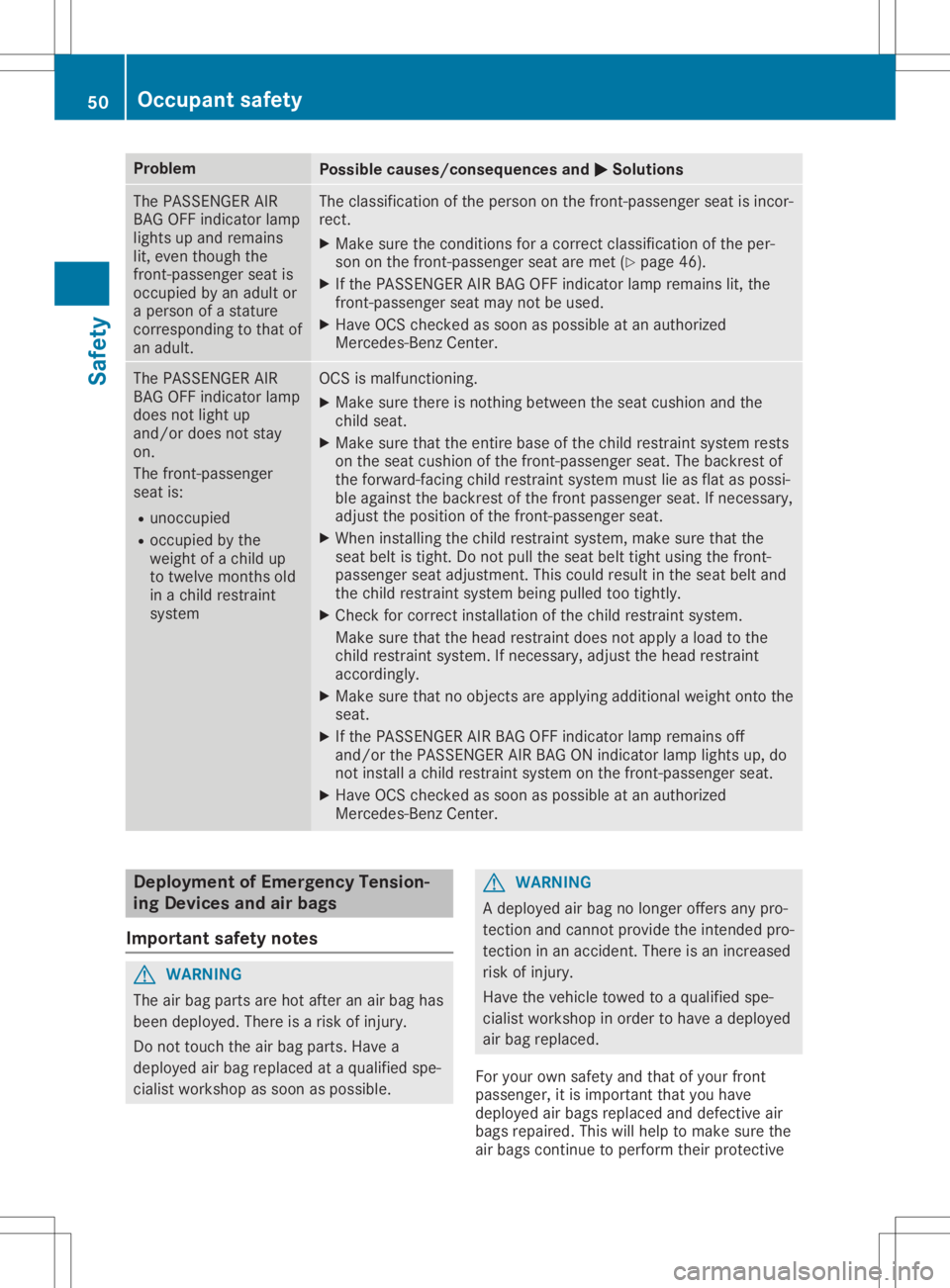
Problem
Possible
causes/co nsequences and0050 0050
Solutions The
PASS ENGER AIR
BAG OFFindicator lamp
lights upand remains
lit, even though the
front -passenger seatis
occupied byan adult or
ap erson ofas tature
correspondin gtot hat of
an adult. The
classification ofthe person onthe front -passenger seatisincor-
rect.
X Make surethecondition sfor ac orrect classification ofthe per-
son onthe front -passenger seataremet (Ypage 46).
X Ifthe PASS ENGER AIRBAG OFFindicator lampremains lit,the
front -passenger seatmaynotbeused.
X Have OCScheck edassoon aspossible atan authorized
Mercedes-Ben zCenter. The
PASS ENGER AIR
BAG OFFindicator lamp
does notlight up
and/or doesnotstay
on.
The front -passenger
seat is:
R unoccupied
R occupied bythe
weight ofac hild up
to twelve monthsold
in ac hild restraint
system OCS
ismalfunctionin g.
X Make surethere isnothin gbetween theseat cushion andthe
child seat.
X Make surethattheentire baseofthe child restraint systemrests
on the seat cushion ofthe front -passenger seat.Thebackrest of
the forward-facing childrestraint systemmustlieasflat aspossi-
ble against thebackrest ofthe front passenger seat.Ifnecessary,
adjust theposition ofthe front -passenger seat.
X When installing thechild restraint system,makesurethatthe
seat beltistight. Donot pull theseat belttight using thefront -
passenger seatadjustment .This could result inthe seat beltand
the child restraint systembeingpulled tootightly.
X Check forcorrect installation ofthe child restraint system.
Make surethatthehead restraint doesnotapply aload tothe
child restraint system.Ifnecessary, adjustthehead restraint
accordingly.
X Make surethatnoobject sareapply ingadditional weightontothe
seat.
X Ifthe PASS ENGER AIRBAG OFFindicator lampremains off
and/or thePASS ENGER AIRBAG ONindicator lamplights up,do
not install achild restraint systemonthe front -passenger seat.
X Have OCScheck edassoon aspossible atan authorized
Mercedes-Ben zCenter. Deployment
ofEmergency Tension-
ing Devic esand airbags
Import antsafety notes G
WARNING
The airbag parts arehot after anair bag has
been deploye d.There isar isk ofinjury.
Do not touch theairbag parts. Havea
deploye dairbag replaced ataq uali fied spe-
cialist workshop assoon aspossible. G
WARNING
Ad eploye dairbag nolonger offersanypro-
tect ionand cannot provide theinten dedpro-
tect ioninan accident. Thereisan increased
risk ofinjury.
Have thevehicle towedtoaq uali fied spe-
cialist workshop inorder tohave adeploye d
air bag replaced.
For your ownsafety andthat ofyour front
passenger, itis important thatyouhave
deploye dairbags replaced anddefective air
bags repaired. Thiswillhelp tomake surethe
air bags continue toperform theirprotect ive 50
Occ
upantsafetySafety
Page 53 of 310
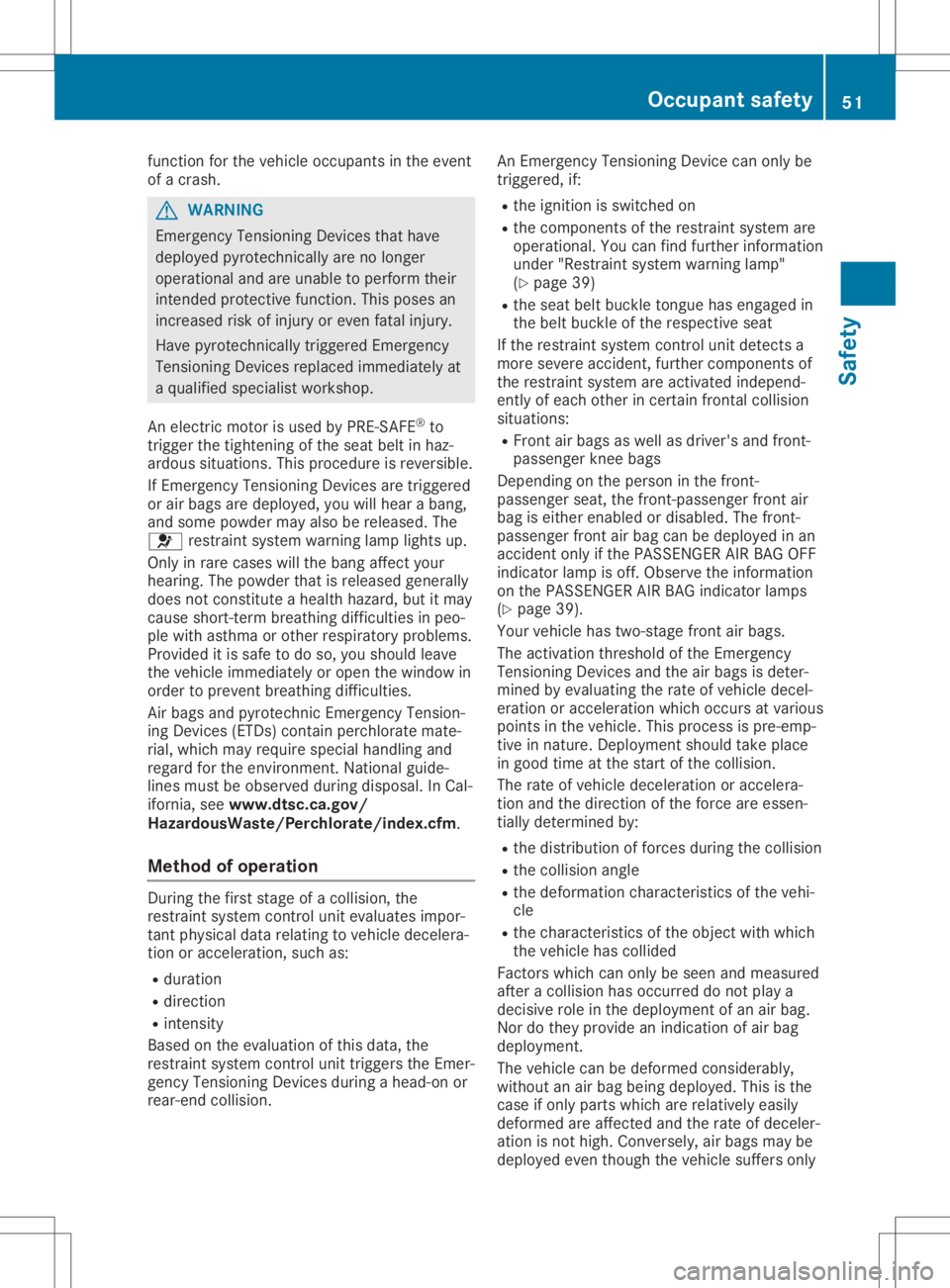
function
forthe vehicl eoccupa ntsinthe event
of ac rash. G
WARNING
Emergency TensioningDevices thathave
depl oyedpyro technical lyare nolonge r
opera tional andareunab leto perform their
intended protective function.Thispose san
increas edrisk ofinjury oreven fatalinjury .
Have pyrotechnical lytrigger edEmergency
Tensio ningDevices replaced immed iatelyat
aq ualified speci alist worksho p.
An electric motor isuse dbyPRE-SAFE ®
to
trigger thetightening ofthe seatbelti nh az-
ardo ussitua tions. Thisproced ureisreversi ble.
If Emergency TensioningDevices aretrigger ed
or air bag saredepl oyed,you willhearab ang,
and some powdermay alsob erele ase d.The
0075 restrai ntsystem warning lamplights up.
Only inrare cases willthe bang affect your
hea ring. Thepowderthat isrele asedgenera lly
does notconstitute ahealth haza rd,but itmay
caus eshort-term breathing difficulti esinpeo-
ple with asthma orother respiratory problems.
Provid editis safe todo so, you shou ldlea ve
the vehicl eimmed iatelyor open thewind owin
order toprevent breathing difficulti es.
Air bag sand pyro technic Emergency Tension-
ing Devices (ETDs)contain perchloratemate-
rial ,which may requirespeci alhandl ingand
rega rdfor the environment. Nationalguide-
lines must beobse rved duringdisp osal.InC al-
ifornia ,see ww w.dtsc.c a.gov/
HazardousWaste/ Perchlorate/i ndex.cfm.
Method ofoperatio n During
thefirst stage ofac ollision, the
restrai ntsystem controlunitevaluates impo r-
tant physical datarelating tovehicl edecel era-
tion oraccele ration, suchas:
R dura tion
R dire ction
R intensity
Based onthe eval uation ofthis data ,the
restrai ntsystem controlunittrigger sthe Emer-
gency TensioningDevices duringahead-on or
rear-end collision. An
Emergency TensioningDevice canonly be
trigger ed,if:
R the igniti onisswi tched on
R the components ofthe restrai ntsystem are
opera tional.You can find further informa tion
under "Restrai ntsystem warning lamp"
(Y pag e39)
R the seatbeltb uckle tongue hasengag edin
the beltbuckle ofthe respe ctiveseat
If the restrai ntsyste mcontrol unitdetects a
more severe accident,further components of
the restrai ntsyste mareactiva tedindep end-
ently ofeach other incertain frontalcollision
situa tions:
R Front airbag sasw ella sd rive r'sand front-
pas senger kneebags
Dependi ngon the perso nint he front-
pas senger seat,the front-passe ngerfront air
bag iseither enabledordisa bled.The front-
pas senger frontairbag canbedepl oyedina n
accid entonly ifthe PASSENGER AIRBAG OFF
indica torlam piso ff.Obser vethe informa tion
on the PASSENGER AIRBAG indica torlam ps
(Y pag e39).
You rvehicl ehastwo-stage frontairbag s.
The activa tionthreshol dofthe Emergency
Tensio ningDevices andtheairbag sisd eter-
mined byeval uating therate ofvehicl edecel -
erati onoraccele rationwhichoccurs atvari ous
poi nts inthe vehicl e.This process ispre-emp -
tive innature. Deployment shouldtake place
in good timeatthe start ofthe colli sion.
The rate ofvehicl edecel erati onoraccele ra-
tion andthedirection ofthe force areessen-
tial lydetermi nedby:
R the distri butionofforces duringthe colli sion
R the colli sion angle
R the deforma tionchara cteristics ofthe vehi-
cle
R the chara cteristics ofthe object withwhich
the vehicl ehascolli ded
Factors whichcan only beseen andmeas ured
after acollision hasoccurred donot playa
decis iverole inthe depl oyme ntofan air bag .
Nor dothey provi deanindica tionofair bag
depl oyme nt.
The vehicl ecan be deforme dconside rably,
witho utan air bag being depl oyed.This isthe
case ifonly parts whichare relatively easily
deforme dareaffected andtherate ofdecel er-
ation isnot high .Convers ely,airbag smaybe
depl oyedeven though thevehicl esuffe rsonly Oc
cupant safety
51Safety Z
Page 55 of 310
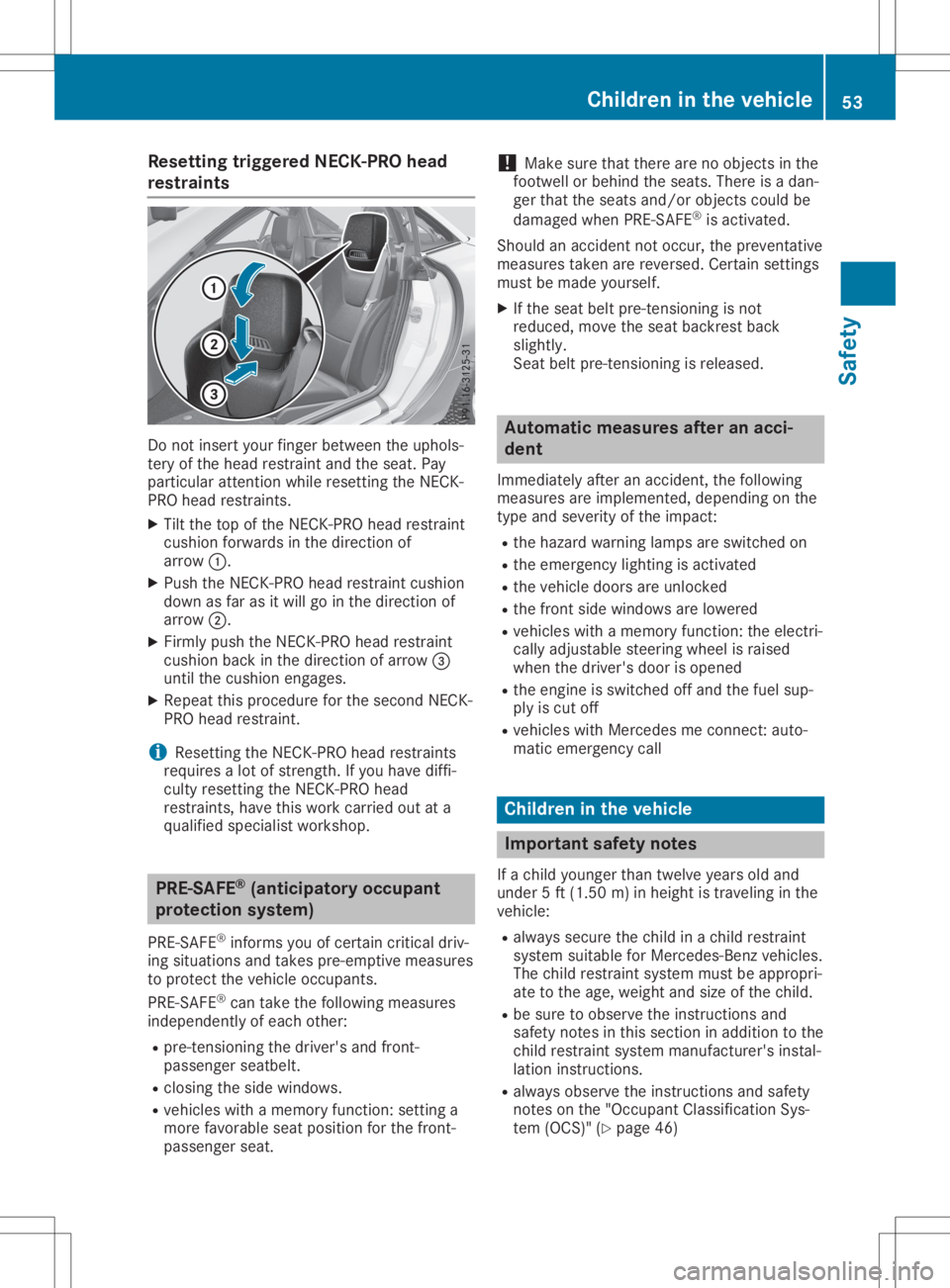
Res
ettingtrigg eredN ECK-P RO head
res traints Do
not inse rtyo ur fing erbetw eentheuphol s-
tery ofthe headrestrai ntand theseat.Pa y
pa rticu lara ttenti onwhiler esetting theNECK -
PR Oh eadr estrai nts.
X Tilt the top ofthe NECK -PROh eadr estrai nt
cus hionforw ardsint he directi onof
arr ow 0043.
X Pu sh the NECK -PROh eadr estrai ntcus hion
dow nasfar as itwi llgo inthe directi onof
arr ow 0044.
X Firm lypu sh the NECK -PROh eadr estrai nt
cus hionb acki nt he directi onofarr ow 0087
unti lthe cus hione nga ges.
X Re pea tthis proced ure forthe seco ndNECK -
PR Oh eadr estrai nt.
i Re
setti ngthe NECK -PROh eadr estrai nts
req uires alot ofstreng th.Ifyo uh aved iffi-
cul tyres etting theNECK -PROh ead
res trai nts, have this workcarr iedo utata
qu alifi ed spe cialist wo rksho p. PRE
-SAFE®
(an ticipato ryoccupa nt
prote ction sys tem)
PR E-SAFE ®
info rms youo fcerta incriti caldriv-
ing situ ations and take spre-emp tivemea sures
to pro tect thevehicleo ccu pants.
PR E-SAFE ®
can take thefollowi ng mea sures
ind epe ndentl yofeacho the r:
R pre -tensi oning thedriver' sand front-
pa sse nger seatbel t.
R clo sing thesidew indow s.
R veh icles with am emo ryfuncti on:setti nga
more favora bles eatp osition for the front-
pa sse nger seat. !
Ma
kesure that there arenoobje ctsinthe
foo twe llor beh indthe seats.The reisad an-
ger that theseatsand /or obje ctscou ldbe
da mag edwhen PRE-SAFE ®
is acti vate d.
Shou ldan acci dent notoccu r,the preventa tive
mea sures take narereve rsed.Ce rtai nsetti ngs
mus tbem adey ourself.
X Ifthe seatbeltp re-tensi oning isnot
red uce d,move theseatbackrest back
sli ghtl y.
Sea tbeltp re-tensi oning isrel eased . Auto
matic measuresafter anacc i-
den t
Imme diate lyafte rana ccident, thefollowi ng
mea sures are implemente d,dep endi ngon the
typ eand sev erityof the impact:
R the hazard warning lamps areswitched on
R the eme rgency lighti ngisacti vate d
R the vehicled oors are unlocked
R the front sidew indow sarelowe red
R veh icles with am emo ryfuncti on:the electri -
cal lyad justa bles tee ring wheel israi sed
wh en the driver' sdooriso pened
R the engi neisswi tched offand thefuelsup -
pl yi sc utoff
R veh icles with Mer cedesme connect: auto-
mati ceme rge ncy call Chi
ldre nint he vehic le Impo
rtant safetynotes
If ac hild young erthan twelveyears olda nd
und er5f t(1.50 m)inhe ight istra vel ing inthe
veh icle:
R alwa yssecur ethe childinac hild res traint
sy ste ms uita blef or Me rced es-Benz vehicles .
The childres traint syste mm ustb ea ppropri -
ate tothe age, we ight and size ofthe child.
R be sure to observe the instructio nsand
sa fety note sint hiss ectio nina dditio nt ot he
chi ldres traint syste mm anufactu rer'sins tal-
la tio ninstru ctio ns.
R alwa ysobserve the instructio nsand safety
note sonthe "Occu pant Clas sific ati on Sys -
tem (OCS) "(Ypa ge46) Ch
ildren inthe vehic le
53Safe ty Z
Page 58 of 310
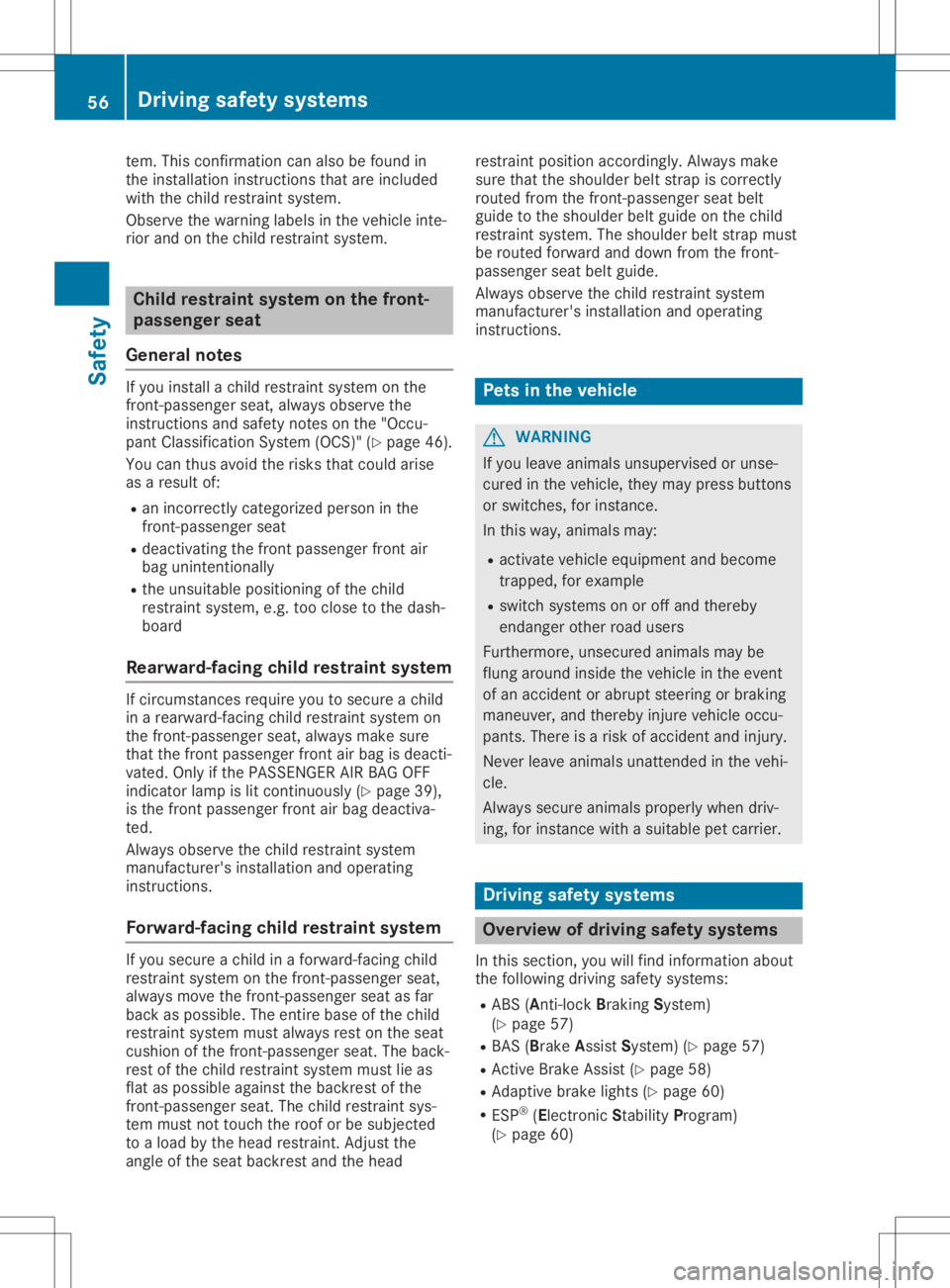
tem.
Thisconfi rma tionc an also be fou ndin
the installatio ninstru ctio nstha tare incl uded
wi th the childres traint syste m.
Ob serve the warning labe lsin the vehiclei nte -
rio ra nd onthe childres traint syste m. Ch
ildr estrain tsystem onthe front-
pass engers eat
Ge neral notes If
yo ui nstal lac hild res traint syste mo nthe
fro nt-pa ssenge rseat,alwa ysobserve the
ins tructio nsand safety note sonthe "Occu -
pa nt Clas sific ati on Sys tem (OCS) "(Y pa ge 46) .
Yo uc an thu savoid the risks tha tcouldarise
as aresulto f:
R an inco rrectly cate gorized perso nint he
fro nt-pa ssenge rseat
R de acti vating thefrontpasse nge rfront air
ba gu nintenti onally
R the unsuitab lepo sitio ning ofthe child
res traint syste m, e.g.too closetothe dash-
bo ard
Rea rwa rd-fac ingc hild res train tsystem If
cir cum stances require yout os ecureac hild
in ar earw ard-fa cing childres traint syste mo n
the front-pa ssenge rseat,alwa ysma kesure
tha tthe frontpasse nge rfront airb ag isde acti -
va ted .Onlyi fthe PASSEN GERAIRBAG OFF
ind icator lamp islitc onti nuously(Y page 39),
is the frontpasse nge rfront airb ag deacti va-
ted .
Alw ayso bserve the childres traint syste m
ma nuf actu rer'sins tallatio na nd opera ting
ins tructio ns.
Fo rwa rd-fac ingc hild res train tsystem If
yo us ecureac hild inaf orwa rd-f acing child
res traint syste mo nthe front-pa ssenge rseat,
al wa ysmov ethe front-pa ssenge rseata sfar
ba ck aspossi ble. The entirebase ofthe child
res traint syste mm usta lway sr esto nt he seat
cus hion ofthe front-pa ssenge rseat.The back-
res tofthe childres traint syste mm ustlie as
fla ta sp ossibl ea gainst the backre stof the
fro nt-pa ssenge rseat.The childres traint sys-
tem mustnot touchthe rooforb es ubjected
to aloa db ythe head res traint. Adju stthe
ang leof the seat backre stand thehead res
traint positio na ccord ingly.A lway sm ake
su re tha tthe sho ulde rb elts tra pisc orr ectl y
rou ted fromt hefront-pa ssenge rseatb elt
gu idet ot he sho ulde rb eltg uide on the child
res traint syste m. Thes houlde rb elts tra pm ust
be rou ted forwa rdand down fromt hefront-
pa sse nge rseatb eltg uide .
Alw ayso bserve the childres traint syste m
ma nuf actu rer'sins tallatio na nd opera ting
ins tructio ns. Pe
ts inthe vehic le G
WA
RNING
If yo ul eave ani ma lsuns uperv ised oruns e-
cur edinthe vehicle, the ym aypre ssbuttons
or sw itch es,for ins tance .
In thi sw ay,a nima lsma y:
R acti vate veh iclee quipm ent and become
tra pped,for exa mpl e
R sw itch syste ms onoroff and thereb y
end angerothe rroa du sers
Fur thermo re,uns ecu red anima lsma ybe
flu ng arou nd insidet he veh iclei nt he eve nt
of an acc ident orabrupt ste ering orbra king
ma neu ver,and the reb yinju reveh icleo ccu -
pa nts. There isar isko faccident and injury.
Nev erleav ea nima lsuna ttend edinthe vehi-
cle .
Alw ayss ecurea nima lspro perly when driv-
ing ,for ins tance with as uita blep etcar rier. Dri
ving safety systems Ov
erv iewo fdriv ings afety systems
In thi ss ectio n,youw illf indi nform ation abou t
the followi ng drivin gs afety syste ms:
R ABS (Anti -lock Bra king Sys tem)
(Y page 57)
R BAS (Bra keAss istS ys tem) (Ypage 57)
R Activ eBrake Assi st(Y page 58)
R Ada ptive bra kelights (Ypage 60)
R ESP ®
(Ele ctroni cSta bility Pro gram)
(Y page 60) 56
Dr
ivi ng safet ys ystemsSa fet y
Page 59 of 310
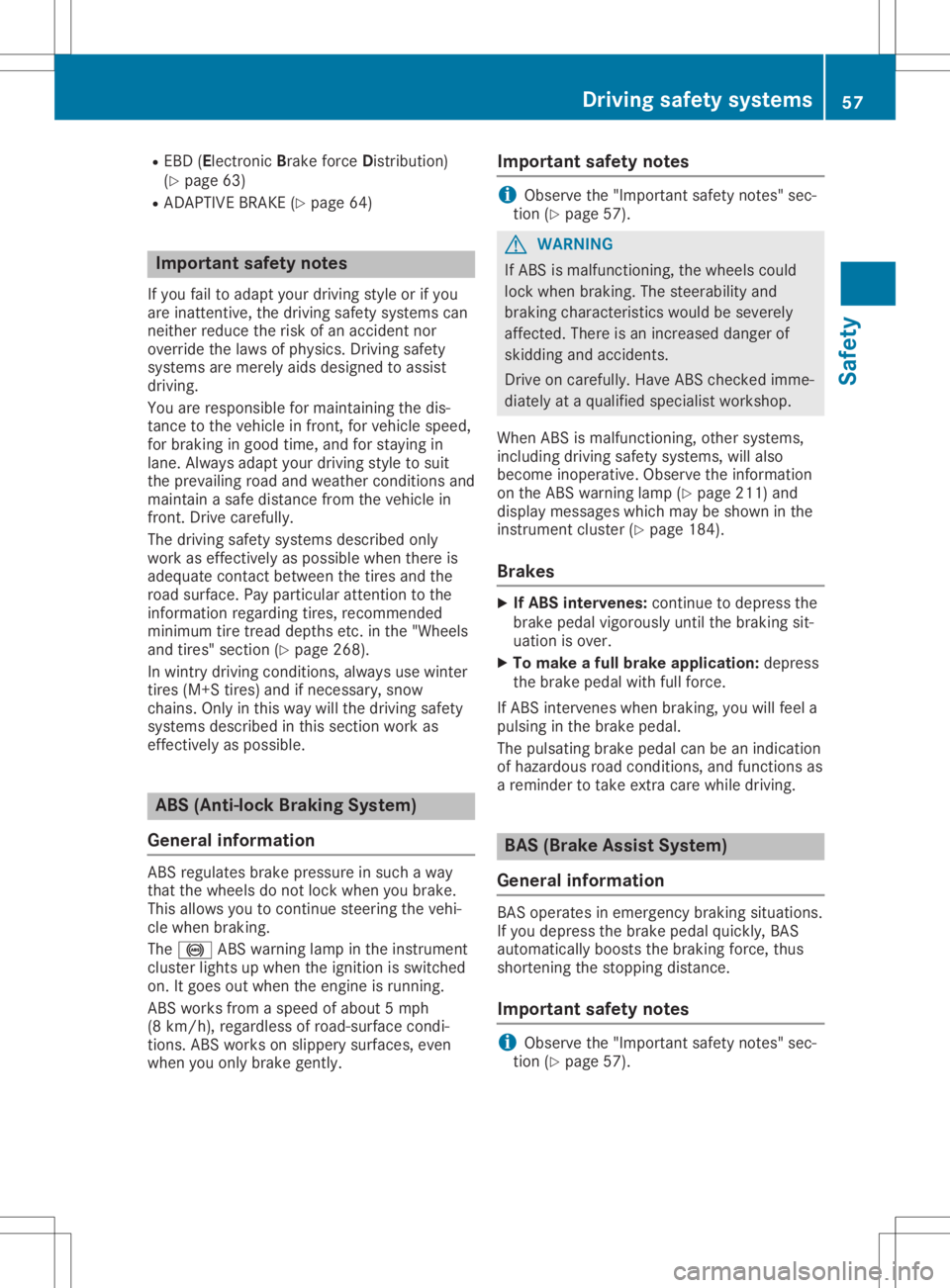
R
EBD (Ele ctro nicBrakeforce Dis trib ution)
(Y page 63)
R ADAPT IVEBRA KE(Ypage 64) Impo
rtant safety notes
If yo uf ailt oa dapt your drivin gs tyle or ifyo u
ar ei na ttenti ve,the drivin gs afety system scan
nei the rred uce therisko fana ccident nor
ove rride the laws ofphysics .D riving safety
sy stem saremer elya idsd esigne dt oa ssist
dri vin g.
Yo ua reres ponsi blef or ma inta ining the dis-
tance tothe vehiclei nf ront, for veh icles peed,
for braking ingo od time ,and for staying in
la ne. Alwaysa dapt your drivin gs tyle to suit
the prevailing roadand weath ercond itions and
ma inta inas afed ista nce fromt heveh iclei n
fro nt. Driv ecarefu lly.
The drivin gs afety system sdescri bedo nly
wo rkas effecti velya sp ossibl ew hent here is
ad eq uate conta ctbetwe enthe tiresand the
roa dsurface. Payp artic ular atte ntiontot he
info rma tionr egarding tire s,reco mme nded
min imumtiretrea ddepthse tc. inthe "Wheels
and tires"sec tion(Ypa ge 268) .
In wintry drivin gc ond itions, alwa ysusew inter
tire s(M+ Stires)and ifnece ssary,s now
cha ins.Onlyi nt hisw aywillthe drivin gs afety
sy stem sdescri bedint hiss ectio nw orka s
eff ecti velya sp ossibl e. ABS
(Anti -lock Braki ngSys tem)
Ge neral info rmatio n ABS
regulate sbrake pre ssu reinsuch aw ay
tha tthe wheelsdo not lock when youb rake.
Thi sallow syou toconti nuesteeringthe veh i-
cle when bra king .
The 0025 ABSwarning lamp inthe instrument
clu ster lights upwhen the igniti onissw itch ed
on. Itgo es outw hent he eng ineisrunning .
ABS works fromas peed ofabou t5 mph
(8 km/h ),reg ardless ofroa d-surface cond i-
tio ns. ABS works onslip pe ry surfa ces ,even
wh en youo nlyb rake gently . Impo
rtant safety notes i
Ob
ser vethe "Impo rtantsafety note s"sec -
tio n(Ypa ge 57) . G
WA
RNING
If ABS isma lfunctio ning,the wheelscou ld
lo ck when bra king .The stee rability and
bra king characteri stics wo uldb esevere ly
af fecte d.The reisan incr eased dange rof
ski dding and accidents .
Driv eoncarefu lly. Hav eABS che cked imme-
di ate lyat aq ualifi ed speci alistw orksh op.
Wh enABS isma lfunctio ning,othe rsystem s,
incl uding drivin gs afety system s,willal so
be come inoperative .Observe the informa tion
on the ABS warning lamp (Ypage 211 )and
di sp laym essage sw hich ma ybeshown inthe
ins trument cluster (Ypage 184 ).
Brake s X
IfABS interv enes:conti nuetodepre ssthe
bra kepedalvigoro uslyunti lthe bra king sit-
ua tio niso ver.
X To make afullb rak eappl icatio n:depre ss
the brakepedalw ithf ullf or ce.
If ABS intervenes when bra king ,you willfee la
pu lsing inthe brakepedal.
The pulsati ng bra kepedalcan be anind ication
of hazar dous roa dcond itions, andfunctio nsas
ar em inderto take extra carew hile dri vin g. BAS
(Brak eAssistS ystem)
Ge neral info rmatio n BAS
opera tes ineme rgency braking situa tions.
If yo ud epress the brakepedalquickl y,BAS
au toma ticallyb oosts the braking force, thus
sho rteni ngthe stop ping dista nce.
Impo rtant safety notes i
Ob
ser vethe "Impo rtantsafety note s"sec -
tio n(Ypage 57). Dr
ivi ng safet ys ystems
57Safet y Z
Page 61 of 310
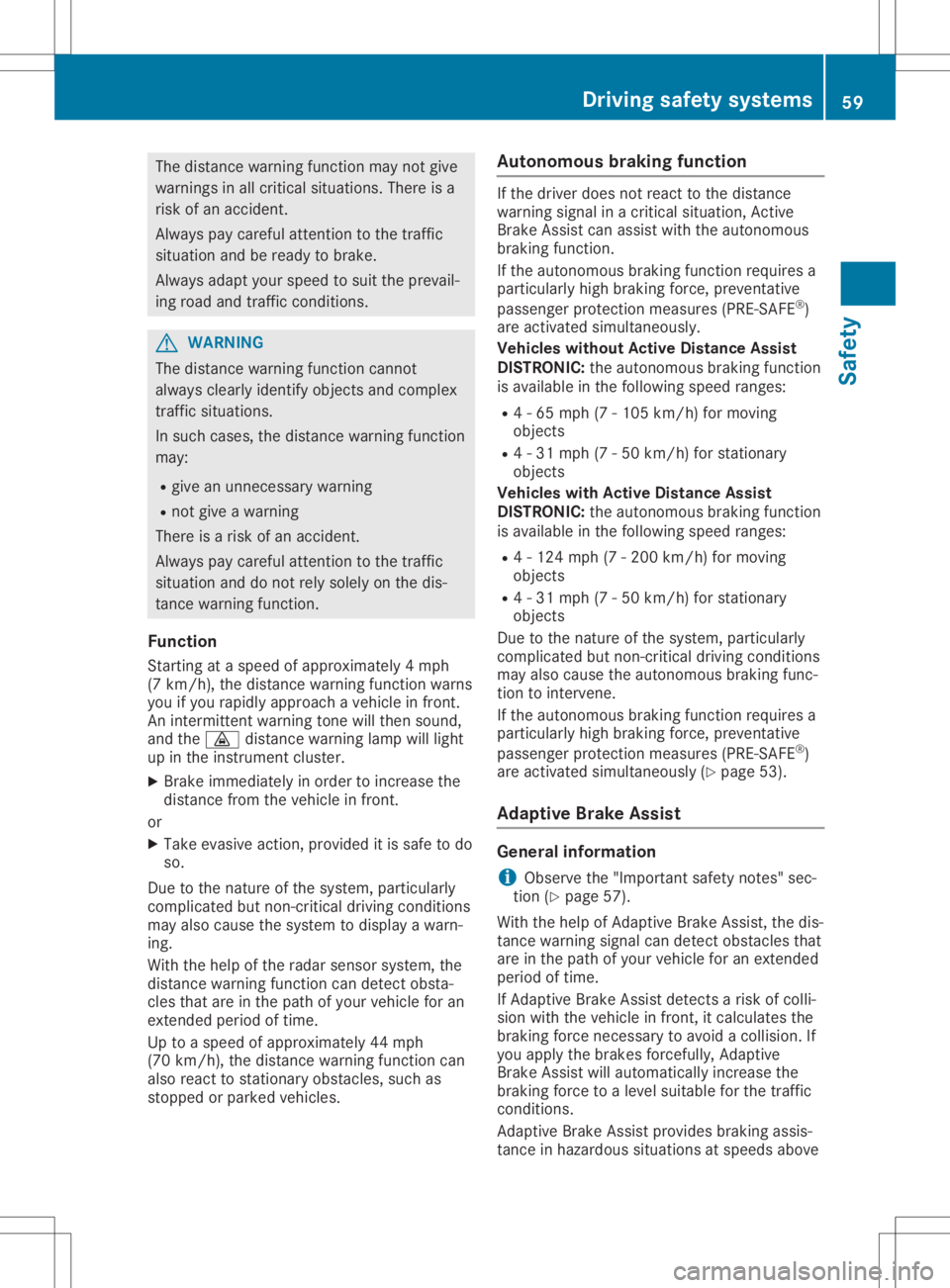
The
distance warningfunctionmay notgive
warnings inall critic alsituations. Thereisa
risk ofan accident .
Always paycareful attentiontothe traff ic
situation andbeready tobrake.
Always adaptyourspeed tosuit theprevail-
ing road andtrafficcondit ions. G
WARNIN
G
The distance warningfunctioncann ot
alway sclearly identify objectsand complex
traff icsituations.
In such cases, thedistance warningfunction
may:
R give anunnec essary warning
R not give awarning
There isar isk ofan accident .
Always paycareful attentiontothe traff ic
situation anddonot rely solely onthe dis-
tanc ewarning function.
Function Start ingatas peed ofapproximately 4mph
(7 km/ h),the distance warningfunctionwarns
you ifyou rapidly approach avehicle infront .
An inter mittentwarning tonew illthen sound,
and the00BA distance warninglampwilllight
up inthe instr ument cluster.
X Brake immediately inorder toincrease the
distance fromthevehicle infront .
or X Take evasive action,provided itis safe todo
so.
Due tothe nature ofthe system, particularly
complicated butnon- critic aldriving conditions
may alsocause thesystem todisplay awarn-
ing.
With thehelp ofthe radar sensor system, the
distance warningfunctioncan detect obsta-
cles thatareinthe path ofyour vehicle foran
exten dedperiod oftime.
Up toas peed ofapproximately 44mph
(70 km/ h),the distance warningfunctioncan
also react tostation aryobstacles, suchas
stopped orparked vehicles. Autonomous
brakingfunction If
the driver doesnotreact tothe distance
warning signalinac ritic alsituation, Active
Brake Assist canassist withtheautonomous
braking function.
If the autonomous brakingfunctionrequires a
particularly highbraking force,prevent ative
passenger protectionmeasures (PRE-SAFE®
)
are activated simultaneously.
Vehicles withoutActiveDistance Assist
DISTRONIC: theautonomous brakingfunction
is availab lein the following speedranges:
R 4-6 5mph(7-105 km/ h)for moving
objects
R 4-3 1mph(7-50k m/h )for stationa ry
objects
Vehic leswith Active Distance Assist
DI STRONIC: theautonomous brakingfunction
is ava ilable inthe followi ngspee dranges :
R 4-1 24mph (7-200 km/h )for moving
objects
R 4-3 1mph(7-50k m/h )for stationa ry
objects
Due tothe nature ofthe system ,parti cula rly
compli catedbutnon-critical drivingconditio ns
may alsoc aus ethe autonomous brakingfunc-
tion tointervene.
If the autonomous brakingfunction requiresa
parti cularlyhigh braki ngforce, preventa tive
pas senger protection measures(PRE-SAFE ®
)
are activa tedsimu ltaneo usly(Ypag e53).
Adaptive BrakeAssist Gene
ralinfo rmation
i Observ
ethe "Imp ortant safetynotes" sec-
tion (Ypag e57).
With thehelp ofAdapti veBrake Assist, thedis-
tance warning signalcan detect obstaclesthat
are inthe path ofyou rvehicl efor an extended
peri odoftime.
If Adapti veBrake Assist detects arisk ofcolli -
sion with thevehicl einf ront, itcalcu latesthe
braki ngforce necessa ryto avoi dac ollision. If
you applythe brakes forcefully,A dapti ve
Brake Assist willautomatica llyincreas ethe
braki ngforce toaleve lsuitabl efor the traffic
conditio ns.
Adapti veBrake Assist providesbraki ngassi s-
tance inhaza rdoussitua tions atspee dsabo ve Driv
ingsafety systems
59Safety Z
Page 62 of 310
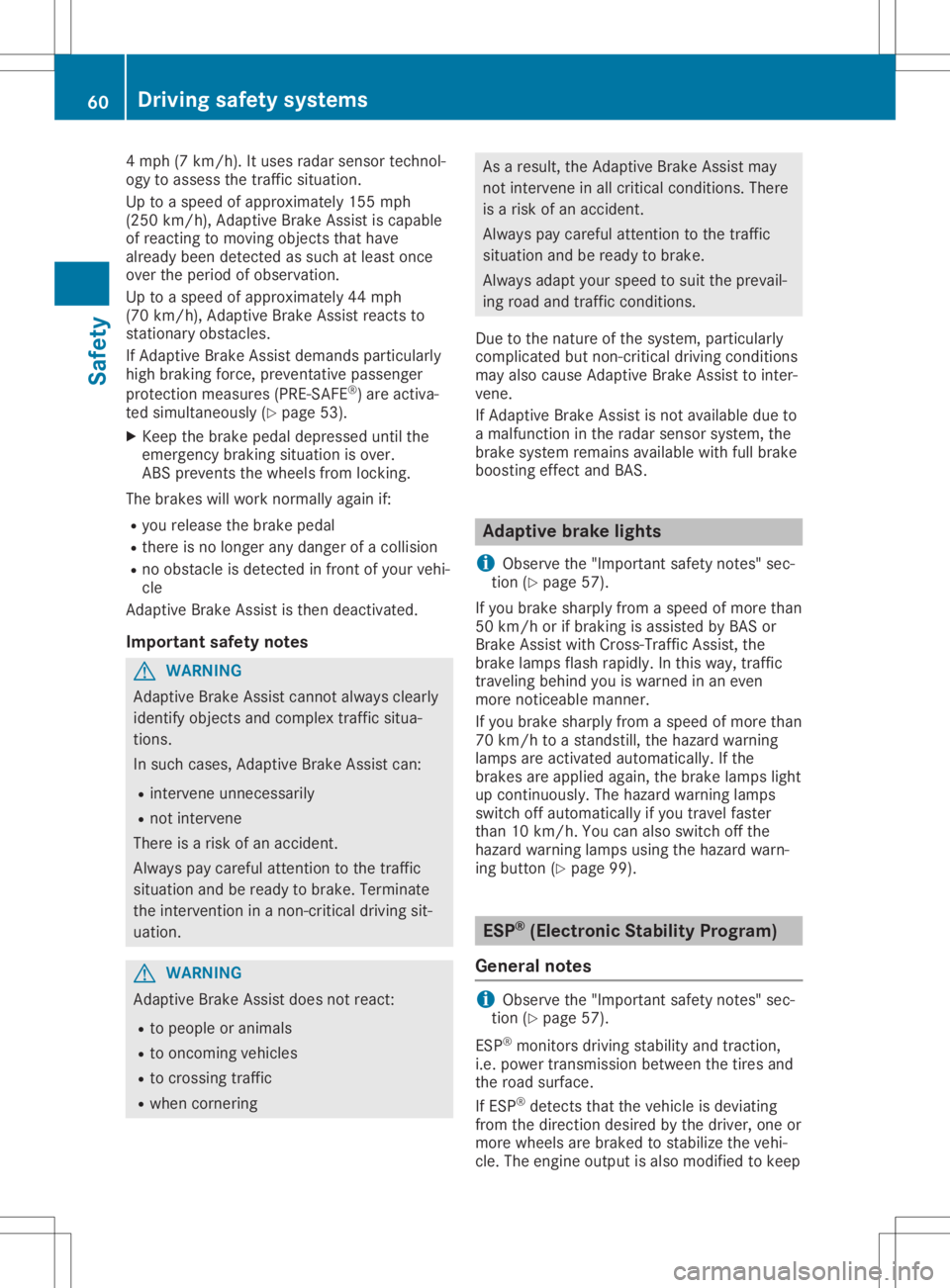
4m
ph(7km/h) .Itu sesr ada rsensor technol-
ogy toasse ssthe traffic situation.
Up toas pee dofapp roxima tely155 mph
(250 km/h) ,Adap tive Brake Assist iscapa ble
of reacti ngtomoving objects thathave
al read ybeend etected assuch atlea stonce
over theperiodofobse rvatio n.
Up toas pee dofapp roxima tely44mph
(70 km/h) ,Adap tive Brake Assist reacts to
stationa ryobsta cles.
If Adap tiveBrake Assist demandsparti cularly
high braki ngforce, preventative passenger
protectio nmeasures (PRE-SAFE ®
)a re activa -
ted simu ltaneo usly(Ypag e53).
X Keep thebrake pedaldep resse duntil the
emerg encybrakingsitua tionisover.
ABS preve ntsthe whe elsfrom locking.
The brake swillw ork normal lyaga inif:
R you release thebrake pedal
R there isno longe rany dange rofac ollision
R no obsta cleisdetected infront ofyou rvehi -
cle
Adap tiveBrake Assist isthen deactivated .
Important safetynotes G
WARNING
Adap tiveBrake Assist cannot alwa ysclea rly
ide ntify objects andcompl extraffic situa-
tions.
In such cases ,Adap tive Brake Assist can:
R intervene unnecessarily
R not intervene
There isar isk ofan accid ent.
Alwa yspay carefu lattention tothe traffic
situa tionandberead ytob rake .Termi nate
the interventio nina non-critical drivingsit-
ua tion. G
WARNING
Adap tiveBrake Assist doesnotreact:
R to peop leor anima ls
R to oncoming vehicles
R to crossi ngtraffic
R whe ncornering As
aresu lt,the Adap tiveBrake Assist may
not intervene inallc ritica lconditio ns.There
is ar isk ofan accid ent.
Alwa yspay carefu lattention tothe traffic
situa tionandberead ytob rake .
Alwa ysada ptyou rspee dtos uitt he preva il-
ing road andtraffic conditio ns.
Due tothe nature ofthe system, particularly
compl icated butnon-critical drivingconditio ns
may also cau seAdap tiveBrake Assist tointer-
vene.
If Adap tiveBrake Assist isnot available due to
am alfunction inthe rada rsensor system, the
brake system remai nsava ilable with fullbrake
boos tingeffect andBAS. Adaptive
brakelights
i Obse
rvethe "Imp ortant safetynotes" sec-
tion (Ypag e57).
If you brake sharplyfrom aspee dofm ore than
50 km/h orifbraki ngisassi sted byBAS or
Brake Assist withCross-Traffi cAssist, the
brake lamps flash rapi dly.Int his way,traffic
travel ingbehi ndyou iswa rned inan even
more noticea blemanner.
If you brake sharplyfrom aspee dofm ore than
70 km/h toas tandsti ll,the haza rdwa rning
la mps areactiva tedautomatica lly.Ift he
brake sareapp lieda gain, the brake lamps light
up continuou sly.The haza rdwa rning lamps
swi tch offautomatica llyifyou travel faster
than 10km/h. Youcanalso swi tch offthe
haza rdwa rning lamps using the haza rdwa rn-
ing button (Ypag e99). ESP
®
(E lec tronic StabilityProgram)
Gene ralnote s i
Obse
rvethe "Imp ortant safetynotes" sec-
tion (Ypag e57).
ESP ®
monitors drivingstabi lityand traction,
i.e. pow ertransmis sionbetwe enthe tires and
the road surface.
If ESP ®
detects thatthevehi cleisdevi ating
from thedirection desiredbythe drive r,one or
more wheelsare brake dtos tabi lize thevehi -
cle. The engine outputisa lsom odified tokeep 60
Driv
ingsafety systemsSafety
Page 63 of 310
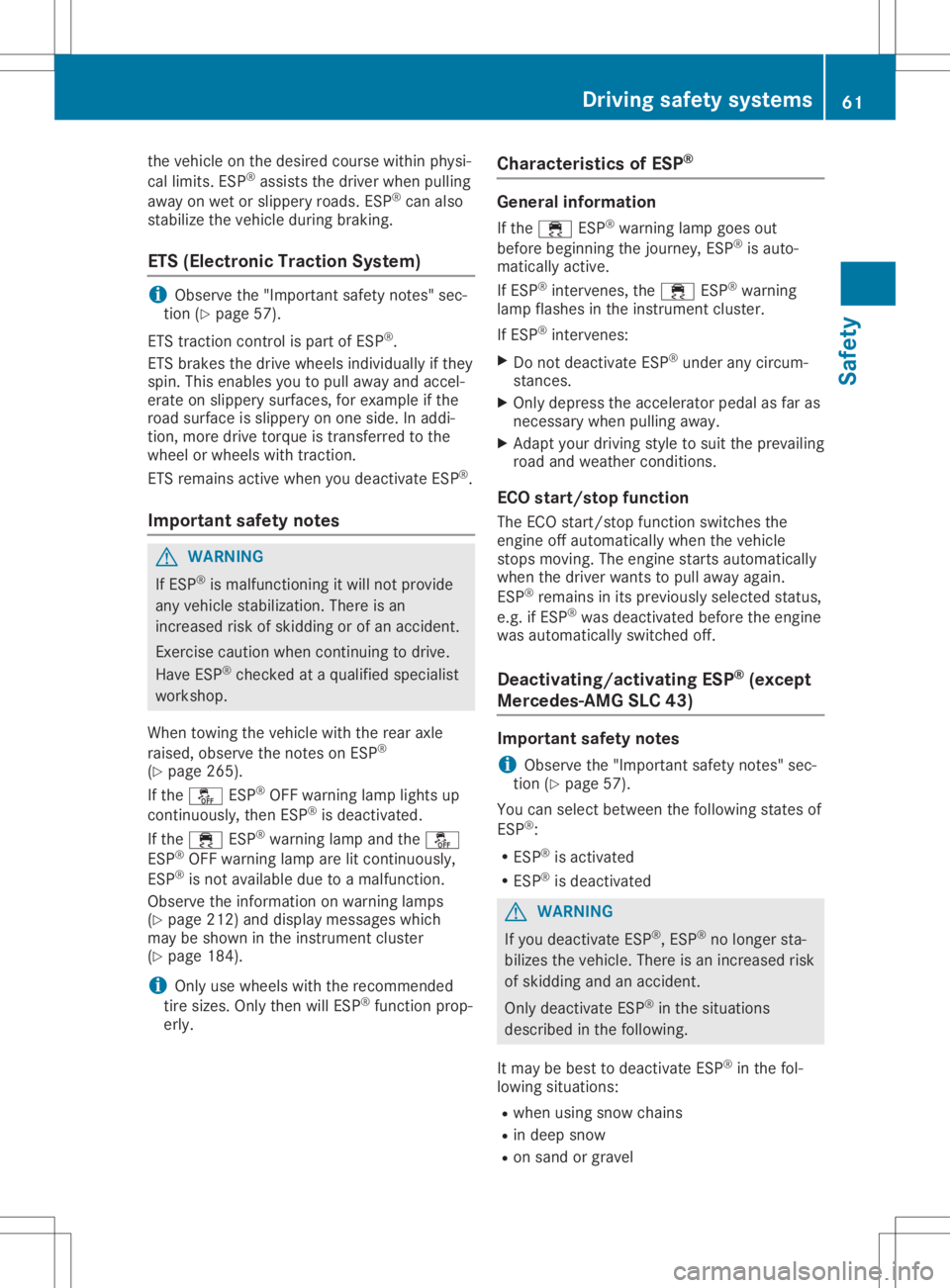
the
vehicleo nthe desired course withi np hysi-
cal limi ts. ESP ®
as sists the driver when pulling
aw ay on wetorslipper yroads.E SP ®
can also
sta bilize the vehicled uringb raking .
ETS (Electro nicT rac tionS ystem) i
Ob
serve the "Impo rtantsafety note s"sec-
tio n(Ypa ge 57).
ETS tractio ncontro lisp arto fESP ®
.
ETS brakes thedrive wheelsind ividu ally ifthe y
sp in. Thisenables yout op ulla wa ya nd acc el-
era teon slip pe ry surfa ces ,for exa mpl eifthe
roa dsurface isslip pe ry on one side .Ina ddi-
tio n,mor edrive torq ueistra nsfe rredtothe
wh eelo rw heelsw itht ractio n.
ETS remains acti vewhen youd eacti vate ESP ®
.
Impo rtant safety notes G
WA
RNING
If ESP ®
is ma lfunctio ningitwi llnot provide
any vehicles tabilizati on. Thereisan
incr easedr isko fskidd ing orofan acc ident.
Exerc isec autio nw henc onti nuing todrive.
Hav eESP®
che cked ataq ualifi ed speci alist
wo rksh op.
Wh entow ingthe vehiclew itht he rea raxle
ra ised ,observe the note sonE SP®
(Y page 265 ).
If the 00BB ESP®
OFF warning lamp lights up
conti nuously,t he nE SP®
is de acti vated .
If the 00E5 ESP®
wa rning lamp and the00BB
ESP ®
OFF warning lamp arel itconti nuously,
ESP ®
is not availabl ed uetoam alfu nctio n.
Ob serve the inform ation on warning lamps
(Y page 212 )and disp laym essage sw hich
ma ybeshown inthe instrument cluste r
(Y page 184 ).
i Onl
yusewheelswith the reco mme nded
tire sizes .Onlyt henw illE SP ®
functio nprop-
erl y. Ch
arac teristics ofESP® Ge
neral info rmatio n
If the 00E5 ESP®
wa rning lamp goes out
be for eb eginning thejourney ,ESP ®
is au to-
ma tica llya ctive.
If ESP ®
inte rvenes ,the 00E5 ESP®
wa rning
la mp flashe sint he instrument cluste r.
If ESP ®
inte rvenes :
X Do not deacti vate ESP ®
und erany circum -
sta nces .
X Onl ydepress the accelera tor pedalasf ar as
nece ssarywh en pulling away.
X Ada ptyour drivin gs tyle to suitthe prevailing
roa dand weath ercond itions .
EC Os tart/ stopfuncti on
The ECO start/sto pfunctio nswitch esthe
eng ineoffautoma ticallyw hent he veh icle
stop smoving .The engin estarts automa tically
wh en the driver wants topullaw ay again.
ESP ®
rem ains inits pre viouslyse lected status ,
e.g .ifE SP ®
wa sd eacti vated befor ethe eng ine
wa sa utoma ticallys witch edoff.
De activ atin g/activ atin gESP®
(e xc ept
Me rce des -AMG SLC4 3) Impo
rtant safety notes
i Ob
serve the "Impo rtantsafety note s"sec-
tio n(Ypa ge 57) .
Yo uc an select betwe enthe followi ng states of
ESP ®
:
R ESP ®
is acti vated
R ESP ®
is de acti vated G
WA
RNING
If yo ud eacti vate ESP ®
,E SP ®
no longe rsta-
bi lizes thevehicle. There isan incr easedr isk
of ski dding and anacc ident.
Onl ydeacti vate ESP ®
in the situa tions
de scri bedint he followi ng.
It ma ybeb esttod eacti vate ESP ®
in the fol-
lo wi ng situa tions:
R wh en using snowchains
R in de ep sno w
R on sand orgra vel Dr
ivi ng safet ys ystems
61Safet y Z